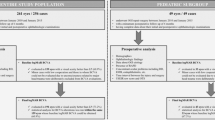Abstract
Objective
The objective of this work is to compare final visual outcomes in cases of surgically treated traumatic cataract between open-globe and closed-globe groups, as classified by the Birmingham Eye Trauma Terminology system.
Design
Observational cohort study.
Setting
Tertiary eye-care center at the trijunction of Gujarat, Madhya Pradesh, and Rajasthan states in central western India.
Methods
We enrolled patients meeting specific inclusion criteria, examined their eyes to review any co-morbidities due to trauma, performed surgery for traumatic cataracts, and implanted lenses. The patients were re-examined 6 weeks postoperatively. We classified the cases of traumatic cataract as either open-globe (group 1) or closed-globe (group 2), according to the Birmingham Eye Trauma Terminology (BETT) system, and compared visual acuity.
Outcome measures
Visual Acuity.
Results
Our cohort of 687 eyes with traumatic cataracts included 496 eyes in group 1 and 191 in group 2. Six weeks postoperatively, the visual acuity was >20/60 in 298 (58%) and 75 (39.1%) operated eyes in groups 1 and 2, respectively (p < 0.001, ANOVA). At follow-up, >20/60 vision was significantly higher in group 1 than in group 2 (OR = 1.61; 95% CI, 0.85–3.02). Overall, 373 eyes (54.3%) regained final visual acuity >20/60.
Conclusions
Open-globe injury has a more favorable prognosis for satisfactory (>20/60) visual recovery after management of traumatic cataracts.

Similar content being viewed by others
References
Khatry SK, Lewis AE, Schein OD, Thapa MD, Pradhan EK, Katz J (2004) The epidemiology of ocular trauma in rural Nepal. Br J Ophthalmol 88:456–460
Abraham DI, Vitale SI, West SI, Isseme I (1999) Epidemiology of eye injuries in rural Tanzania. Ophthalmic Epidemiol 6:85–94
Alfaro DV, Jablon EP, Rodriguez Fontal M, Villalba SJ, Morris RE, Grossman M, Roig-Melo E (2005) Fishing-related ocular trauma. Am J Ophthalmol 139:488–492
Shah M, Shah S, Khandekar R (2008) Ocular injuries and visual status before and after their management in the tribal areas of western India—a historical cohort study. Grafes Arch Clin Exp Ophthalmol 246:191–197
Kuhn F, Morris R, Witherspoon CD, Mester V (2004) The Birmingham Eye Trauma Terminology system (BETT). J Fr Ophtalmol 27:206–210
Weinand F, Plag M, Pavlovic S (2003) Primary implantation of posterior chamber lenses after traumatic cataract penetration. Ophthalmology 100:843–846
Baykara M, Dogru M, Ozçetin H, Ertürk H (2002) Primary repair and intraocular lens implantation after perforating eye injury. J Cataract Refract Surg 28:1832–1835
Mohammad pour M, Jafarinasab MR, Javadi MA (2007) Outcomes of acute postoperative inflammation after cataract surgery. Eur J Ophthalmol 17:20–28
Khvatova AV, Kruglova TB (1992) Intraocular correction in the restorative therapy of children with congenital and traumatic cataracts. Vestn Oftalmol 108:18–21
Corbett MC, Shilling JS, Holder GE (1995) The assessment of clinical investigations: the Greenwich Grading System and its application to electro diagnostic testing in ophthalmology. Eye 9:59–64
Segev Y, Goldstein M, Lazar M, Reider-Groswasser I (1995) CT appearance of a traumatic cataract. AJNR Am J Neuroradiol 16:1174–1175
McWhae JA, Crichton AC, Rinke M (2003) Ultrasound biomicroscopy for the assessment of zonules after ocular trauma. Ophthalmology 110:1340–1343
Zhang Y, Zhang J, Shi S (1998) Determination of posterior lens capsule status in traumatic cataract with B-ultrasonography. Zhonghua Yan Ke Za Zhi 34:298–299
Brar GS, Ram J, Pandav SS, Reddy GS, Singh U, Gupta A (2001) Postoperative complications and visual results in uniocular pediatric traumatic cataract. Ophthalmic Surg Lasers 32:233–238
Wos M, Mirkiewicz-Sieradzka B (2004) Traumatic cataract—treatment results. Klin Oczna 106:31–34
Baklouti K, Mhiri N, Mghaieth F, El Matri L (2005) Traumatic cataract: clinical and therapeutic aspects. Bull Soc Belge Ophtalmol 298:13–17
Vatavuk Z, Pentz A (2004) Combined clear cornea phacoemulsification, vitrectomy, foreign body extraction, and intraocular lens implantation. Croat Med J 45:295–298
Morgan KS (1993) Cataract surgery and intraocular lens implantation in children. Curr Opin Ophthalmol 4:54–60
Thylefors B, Chylack LT Jr, Konyama K, Sasaki K, Sperduto R, Taylor HR (2002) A simplified cataract grading system. Ophthalmic Epidemiol 9:83–95
American Society of Ocular Trauma. Ocular trauma Score (OTS) http://www.asotonline.org/ots.html accessed on 10/12/2008
Behbehani AM, Lotfy N, Ezzdean H, Albader S, Kamel M, Abul N (2002) Open eye injuries in the pediatric population in Kuwait. Med Princ Pract 11:183–189
Cillino S, Casuccio A, Di Pace F, Pillitteri F, Cillino GA (2008) Five-year retrospective study of the epidemiological characteristics and visual outcomes of patients hospitalized for ocular trauma in a Mediterranean area. BMC Ophthalmol 22:6–8
Smith AR, O'Hagan SB, Gole GA (2006) Epidemiology of open- and closed-globe trauma presenting to Cairns Base Hospital, Queensland. Clin Exp Ophthalmol 34:252–259
Krishnamachary M, Rathi V, Gupta S (1997) Management of traumatic cataract in children. J Cataract Refract Surg 23:681–687
Vajpayee RB, Sharma N, Dada T, Gupta V, Kumar A, Dada VK (2001) Management of posterior capsule tears. Surv Ophthalmol 45:473–488
Conflicting interests
None.
Author information
Authors and Affiliations
Corresponding author
Additional information
No financial support was received from any company or institution.
This study has not been presented at any conference or meeting.
The authors have no financial interest in any aspect of this study.
Electronic supplementary material
Below is the link to the electronic supplementary material.
ESM1
(DOC 26 kb)
Rights and permissions
About this article
Cite this article
Shah, M.A., Shah, S.M., Shah, S.B. et al. Comparative study of final visual outcome between open- and closed-globe injuries following surgical treatment of traumatic cataract. Graefes Arch Clin Exp Ophthalmol 249, 1775–1781 (2011). https://doi.org/10.1007/s00417-011-1732-7
Received:
Revised:
Accepted:
Published:
Issue Date:
DOI: https://doi.org/10.1007/s00417-011-1732-7




